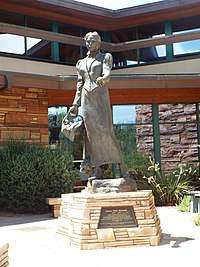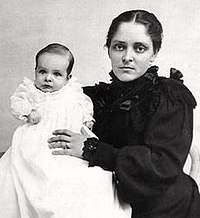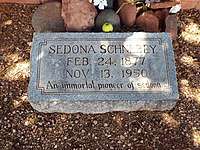Sedona Schnebly
Sedona Schnebly (February 24, 1877 - November 13, 1950) was an early pioneer in the Oak Creek area of Arizona. She was the namesake of the town of Sedona, Arizona. She helped in the establishment of the family farm and general store in the town. She also served as the town's bible school teacher. Sedona saved funds to build the Wayside Chapel. Among her legacy is a sculpture of a statue in her likeness by the Sedona Red Rocks Arts Council honoring her memory.
Sedona Schnebly | |
|---|---|
 Statue of Sedona Schnebly in the Sedona Public Library | |
| Born | Sedona Arabella Miller February 24, 1877 |
| Died | November 13, 1950 |
| Resting place | Cooks Cedar Glade Cemetery in Sedona, Az |
| Nationality | American |
| Other names | Dona |
| Known for | Namesake of the Town of Sedona, Arizona |
| Spouse(s) | Theodore Carlton Schnebly |
Early years
Sedona Schnebly (birth name: Sedona Arabella Miller) was born in the town of Gorin, Missouri (later renamed South Gorin Missouri) to Philip and Amanda Miller. Her mother made up the name of Sedona which she named her child, however she was known as "Dona" a name which most people called her most of her life.[1][2][3][4]
She attended the Gorin Academy where she received her basic education and learned to play the piano. After she graduated Sedona earned a living as a teacher. When she was 20 years old she met Theodore Carleton (T C) Schnebly, an enterprising young man. They fell in love, however her parents objected to their relationship because of religious reasons. The Millers were Methodist and Theodore Carleton Schnebly was a Presbyterian.[1][2][3][4]
Arizona

Theodore Schnebly's brother, Ellsworth had previously moved to the Oak Creek region of Arizona for health reasons upon the recommendation of his medical doctor. Ellsworth wrote to the Schneblys' encouraging them to move to Arizona which had plenty of land with deep grass, crystal clear air and plenty of room. Convinced by Ellisworth, the Schnebly's told Sedona's parents about their plans of moving to the West (Arizona). Sedona's parents did not approve of their plans and this eventually caused a rift in the families relations.[1][2][3][4]
Theodore arrived in Oak Creek, which called the red rock country, before the rest of the family. Together with other pioneer families, he blasted out irrigation routes and moved the water through ditches, flumes and pipelines. He purchased twelve acres for a farm and an orchard in the area known as Camp Garden, which was along Oak Creek. He began to haul his produce goods to the City of Flagstaff where he sold them and then he would return to his farm in Oak Creek with goods from that city.[1][2][3][4]
Theodore sent for his wife Sedona and their two children. She mounted a train with her children and belongings that was headed to the mining town of Jerome. Theodore was waiting in Jerome for his family to arrive and when they did he put his family and family possessions on a wagon and headed towards Oak Creek. They all arrived to their new home on October 12, 1901. They built a two-story house and established a small store where they sold their goods to the local residents. The Schnebly's hired road crews to build what is now known as Schnebly Hill Road. This road provided a much better way to take their crops to Flagstaff.[1][2][3][4]
How Sedona got its name

Their large house served as a boarding residence for visitors. The guests never paid more than $1 a day for room and board. There wasn't enough room in the house for all the guests and therefore Sedona and her husband placed tenthouses on their property. Not only did Sedona cook for everyone and tend to her children, but she also helped in the farm, made soap and canned fruits and vegetables.[1][2][3][4]
The Schnebly's believed that the fast growing community needed a post office. Theodore wanted to be the areas first postmaster and began to organize a post office. He wrote to the Postmaster General in Washington, D.C. and suggested the following names "Oak Creek Crossing" and "Schnebly Station". However, the Postmaster General considered both names too long and therefore rejected them. Ellsworth, Theodore's brother, suggested that he submit the name of "Sedona" his wife. Theodore did and on June 26, 1902, the name was approved by the Postmaster General.[1][2][3][4]
The Schnebly family tragedy
On June 12, 1905, Sedona's five-year-old daughter Pearl was killed when she became tangled in the reigns on her pony and she was trampled to death. They buried their daughter in their front yard and Sedona became very depressed. The Schnebly's returned to Missouri in an effort to improve Sedona's heath.[1][2][3][4]
Sedona's husband eventually decided that he would like to return to farming and the family moved to Boyero, Colorado. Their economic situation was a difficult one and Theodore's health worsened. His medical doctor recommended that he should return to Arizona for health reasons and they did.[1][2][3][4]
Back in Sedona

In 1930, they moved to Phoenix and that same year they returned to Sedona. There was nothing left of their homestead and they had no other choice then to rent a small one-room house on Jordan Road. Both, Sedona and Theodore were given jobs in the orchards owned by Ruth and Walter Jordan. Sedona helped Ruth with the cleaning and cooking and care of the Jordan's three children. She also washed and ironed Civilian Conservation Corps boys' uniforms for 10 cents per shirt.[1][2][3][4]
Sedona Schnebly taught bible at the American Sunday School and she saved money to fund the building of a religious chapel. In 1950, the Wayside Chapel just off Highway 89A was completed and dedicated to Sedona Schenebly. Sedona was suffering from cancer and on November 13, 1950, she died. Her husband Theodore, outlived her by almost four years, he died March 13, 1954. both Sedona and Theodore are buried in Cooks Cedar Glade Cemetery off Airport Road. The remains of their daughter Pearl were also moved to Cooks Cedar Glade Cemetery.[1][2][3][4]
Legacy
On February 14, 2012, the Sedona Schnebly Memorial bell was rung at 2:14 during the Arizona Centennial celebration of Statehood in front of the Wayside Chapel.[1][2][3][4]
The Red Rock Quilters guild completed an Arizona Centennial quilt featuring an image of Sedona Schnebly picking apples against a background of some of the town of Sedona's most famous views.[1][2][3][4]
A statue with the likeness of Sedona was commissioned by the Sedona Red Rocks Arts Council to honor Sedona's memory. The statue which was made in 1964 by Susan Kliewer, a local artist was unveiled in October 1, 1994 in front of the Sedona Public Library located at 3250 White Bear Road. It was Sedona's first Art in Public Places project. The plaque on the base of the statue reads as follows[1][2][3][4]
Region: North Central Arizona
Theme: Women in Domestic Life, Women and Community Building
The town of Sedona dedicated a garden to her, the Sedona Schnebly Memorial Garden which is located at 260 Schnebly Hill Road.[1][2][3][4]
Further reading
- "The Journal of Sedona Schnebly"; by: Lisa Schnebly Heidinger; Publisher: Cider Press; ISBN 0930831098; ISBN 978-0930831097.
See also
- Sedona, Arizona
- List of historic properties in Sedona, Arizona
- List of American places named after people